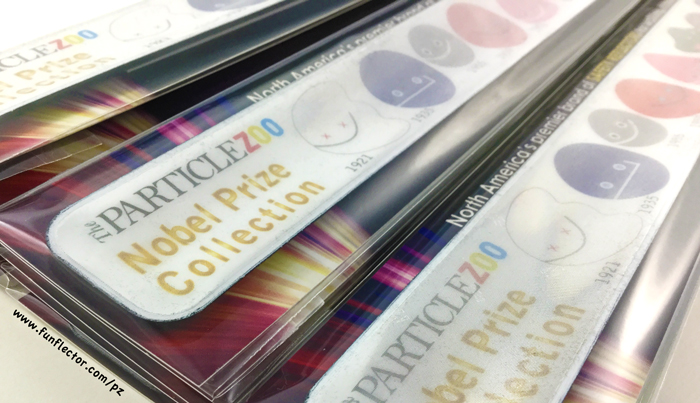Celebrate groundbreaking research in high-energy physics with this collection of happy elementary particles from discoveries that brought home the Nobel Prize. In cooperation with the ParticleZoo, we have created a highly reflective slap bracelet (order it here) that doubles as a cheat sheet for Nobel Prize trivia while waiting for the 2017 Nobel Prize announcements.

The Particle Zoo Nobel Prize Collection
For the curious, the Nobel Prize website lists all awarded prizes and below are the first three selected for our reflective slap bracelet:
1921 – The Photon
Albert Einstein was awarded “for his services to Theoretical Physics, and especially for his discovery of the law of the photoelectric effect”. Electromagnetic radiation, which is visible light, infrared, ultraviolet, radio waves, radar, x-rays, microwaves, etc. behaves both as a wave and a particle, the photon. When light (photons) hit a metal plate, they knock out electrons from their atoms. That is called the photoelectric effect and the emitted electrons are called photoelectrons.
1935 – The Neutron
James Chadwick received the Nobel Prize “for the discovery of the neutron” in 1920. Neutrons along with protons make up the mass of an atom’s nucleus. All atoms of a specific element has equal number of protons and electrons. However, the number of neutrons can vary and the quantity determines the mass and radioactive properties of the nucleus. Read more about the discovery of the neutron >
1955 – The Electron
J. J. Thomson discovered the first elementary particle, the electron, in 1897, for which he received the Nobel Prize in 1906. In 1955, the electron again was involved in experiments awarded with the prize: Willis Eugene Lamb “for his discoveries concerning the fine structure of the hydrogen spectrum” and Polykarp Kusch
“for his precision determination of the magnetic moment of the electron”. The latter became an important puzzle piece in the development of quantum electrodynamics, QED.
Continue to the next Nobel Prize: The antiproton in 1959 and on…

